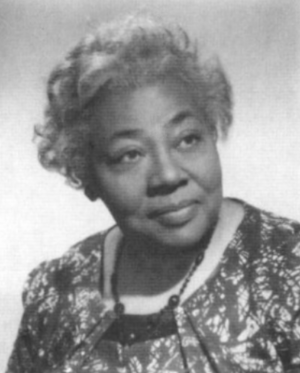Eva Jessye facts for kids
Quick facts for kids
Eva A. Jessye
|
|
|---|---|

Eva A Jessye from a 1923 publication
|
|
| Born | January 20, 1895 Coffeyville, Kansas
|
| Died | February 21, 1992 (aged 97) Ann Arbor Michigan
|
| Known for | Choral conductor |
Eva Jessye (born January 20, 1895 – died February 21, 1992) was an amazing American conductor. She was the first Black woman to become famous around the world as a professional choir leader. She was a very important person during the Harlem Renaissance, a time when Black artists, writers, and musicians created many new things.
Eva Jessye started her own choir group. This group performed in many places. She also taught music for many years, influencing many people. Her achievements were historic for any woman in music. She worked on big, new musical shows. She directed her choir for Four Saints in Three Acts (1933) with Virgil Thomson and Gertrude Stein. She also worked as the music director for George Gershwin's famous opera Porgy and Bess (1935).
Contents
Early Life and Musical Journey
Eva Jessye was born on January 20, 1895, in Coffeyville, Kansas. She went to college at Western University and Langston University. Both were colleges mainly for Black students. Later, she studied music privately in New York City.
In 1919, Eva Jessye started leading the choir at Morgan State College in Baltimore. She then taught for a while in Oklahoma. In 1926, she returned to Baltimore. There, she began performing regularly with her group, the "Eva Jessye Choir." She first called them the "Original Dixie Jubilee Singers." But many other groups started using a similar name. So, she changed her group's name to avoid confusion.
Her choir moved to New York City. They often performed in shows at the Capitol Theatre. They also performed a lot on radio stations like NBC and WOR in the 1920s and 1930s. They made recordings for several record companies. In 1929, Jessye went to Hollywood. She was the choir director for the movie Hallelujah!. This film had an all-Black cast. She spoke out against unfair treatment she faced while working on the movie. Many Black newspapers praised her for speaking up.
Working on Famous Shows
In New York, Eva Jessye worked with different groups of people on new and exciting shows. These shows tried out new forms of music and storytelling. In 1933, she led her choir in an opera called Four Saints in Three Acts. This opera was created by Virgil Thomson and Gertrude Stein. It was performed on Broadway.
Working on Four Saints was a big step forward for Black singers. Before this, Black singers often only got to perform certain types of songs. Eva Jessye said that this opera was "quite a departure." It made her choir try something "foreign to our nature completely." She also fought to make sure her singers were paid for rehearsals. This was important because singers often faced unfair pay and didn't get paid for practice time.
In 1935, a famous composer named George Gershwin chose her. He wanted her to be the music director for his opera Porgy and Bess. This was another very important job.
Her Own Music and Activism
In 1927, Eva Jessye published a book called My Spirituals. It was a collection of her own musical arrangements of spiritual songs. It also included stories about her childhood in Kansas.
She also wrote her own musical works for choirs:
- The Life of Christ in Negro Spirituals (1931)
- Paradise Lost and Regained (1934), which was a folk oratorio (a large musical work)
- The Chronicle of Job (1936)
These works combined spiritual songs, religious stories, and her own music for orchestras.
Eva Jessye strongly supported the Civil Rights Movement. She and her choir took part in the famous 1963 March on Washington for Jobs and Freedom. This was a very important event in American history.
Later Life and Legacy
Eva Jessye continued to be active even in her 80s. She taught at Pittsburg State University and the University of Michigan. She gave her large collection of books, music, art, and other items to the University of Michigan. This collection became the start of the university's African American Music Collection.
Just before she passed away in Ann Arbor, Michigan, she created the Eva Jessye African-American Music Collection at the University of Michigan. She also left most of her personal papers to Pittsburg State University in Kansas. Her work and collections continue to teach people about African-American music and history.
See also
 In Spanish: Eva Jessye para niños
In Spanish: Eva Jessye para niños


